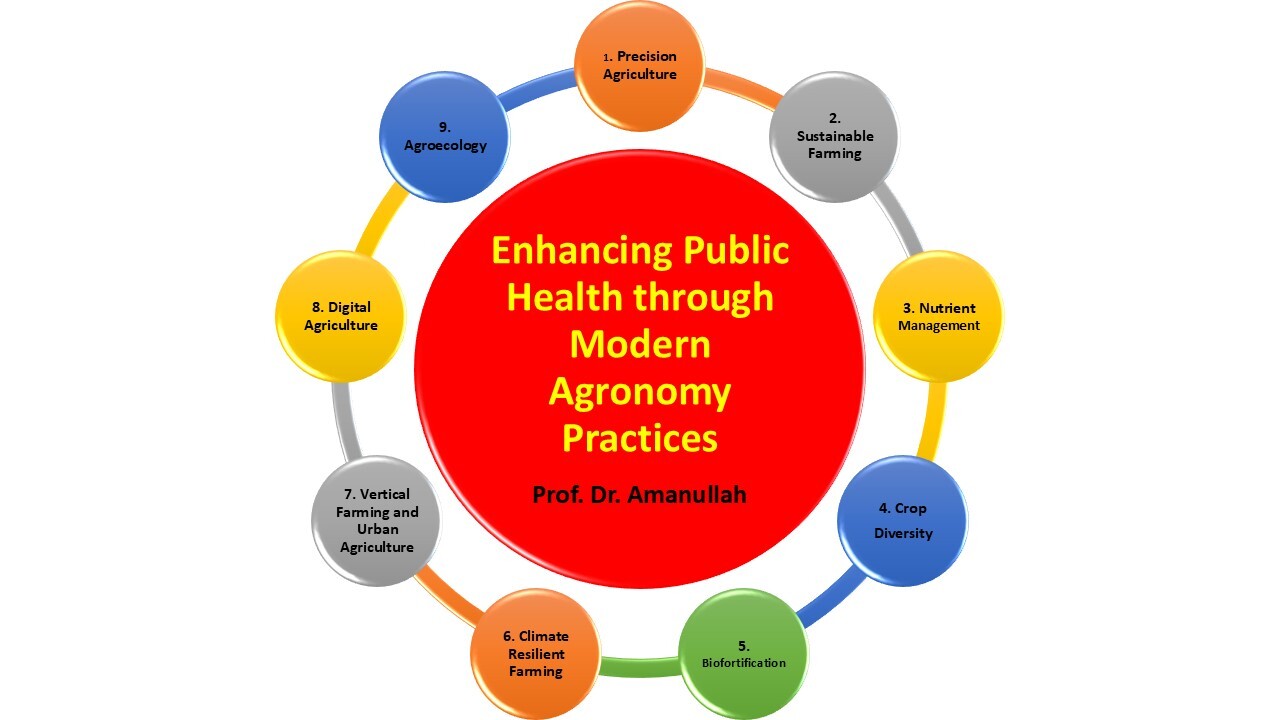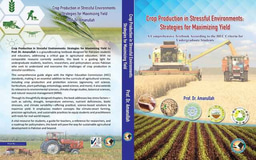Enhancing public health through modern agronomy: Sustainable and nutrient-rich practices
Published in Earth & Environment, Sustainability, and Plant Science

Introduction
In an era defined by climate uncertainty, ecological degradation, and rising health concerns, agriculture finds itself at a crucial crossroads. No longer just a means of food production, agriculture today plays a vital role in shaping public health outcomes. At this intersection lies modern agronomy—an evolving field that leverages scientific innovation, sustainable practices, and technological advancements to nourish both people and the planet. This blog explores how contemporary agronomic strategies are redefining agriculture's role in promoting community well-being, food security, and nutritional resilience.
1. Precision Agriculture: Data-Driven, Health-Oriented Farming
Precision agriculture integrates advanced technologies—such as GPS mapping, IoT sensors, and AI—to fine-tune farming inputs like water, fertilizer, and pesticides. This ensures crops receive what they need when they need it.
Public Health Impact:
-
Produces more nutrient-dense crops, addressing hidden hunger.
-
Reduces chemical use, lowering exposure risks for consumers and farmers.
-
Enhances food security by increasing yields sustainably.
As climate patterns shift unpredictably, precision agriculture offers a scalable, adaptable solution for ensuring stable food supplies while improving dietary quality.
2. Sustainable Farming: Cultivating Healthier Soils and Safer Foods
Practices such as crop rotation, organic farming, and integrated pest management contribute to soil vitality and minimize environmental contamination.
Public Health Impact:
-
Reduces pesticide residues in food and water sources.
-
Improves biodiversity, which supports more resilient food systems.
-
Promotes long-term food safety and environmental health.
Sustainable farming is not just good for the environment—it’s a direct investment in healthier communities.
3. Nutrient Management: Feeding the Soil to Feed the World
Efficient nutrient management involves optimizing the application of macronutrients (NPK) and micronutrients based on plant needs and environmental conditions.
Public Health Impact:
-
Increases nutrient content in crops, improving dietary value.
-
Minimizes harmful runoff, protecting aquatic ecosystems and water safety.
-
Reduces reliance on synthetic fertilizers, cutting greenhouse gas emissions.
With the right nutrient balance, we can grow crops that nourish populations and ecosystems alike.
4. Crop Diversity: A Buffer Against Malnutrition and Climate Shock
Growing a variety of crops not only enhances dietary diversity but also fortifies food systems against pests, diseases, and climate stresses.
Public Health Impact:
-
Diversifies nutrient intake, reducing reliance on calorie-dense staples.
-
Helps mitigate micronutrient deficiencies (e.g., iron, zinc, vitamin A).
-
Supports food security by reducing the risk of total crop failure.
Diverse fields mean diverse diets—an essential foundation for nutritional well-being.
5. Biofortification: Boosting Nutrition at the Root
Biofortification enriches crops with essential vitamins and minerals through plant breeding or biotechnology.
Public Health Impact:
-
Provides sustainable access to essential nutrients in low-resource settings.
-
Reduces the prevalence of deficiency-related diseases such as anemia and stunting.
-
Improves cognitive function and overall health, especially in children.
It’s a low-cost, high-impact approach to combatting malnutrition from the ground up.
6. Climate-Resilient Farming: Building Agricultural Immunity
Climate-resilient farming includes drought-tolerant crop varieties, conservation agriculture, and water-efficient irrigation systems.
Public Health Impact:
-
Secures food supplies during climate extremes.
-
Enhances dietary stability and nutrition.
-
Reduces vulnerability to climate-induced health risks (e.g., malnutrition, waterborne diseases).
Adaptation is not just a necessity—it's a public health imperative.
7. Vertical Farming and Urban Agriculture: Healthier Cities from the Ground Up
Urban agriculture and vertical farming bring food production closer to consumers, especially in densely populated areas.
Public Health Impact:
-
Improves access to fresh, nutritious produce in urban food deserts.
-
Reduces dependence on long, emissions-heavy supply chains.
-
Engages communities in food education and healthy lifestyle practices.
By greening our cities, we’re also cultivating healthier futures.
8. Digital Agriculture: Smart Tech for Smarter Nutrition
Digital tools such as remote sensing, AI-powered diagnostics, and real-time monitoring enhance farm decision-making.
Public Health Impact:
-
Enables precise nutrient applications, improving crop quality.
-
Enhances traceability and safety across food supply chains.
-
Promotes transparency in production practices, empowering healthier consumer choices.
Technology isn’t just transforming farming—it’s transforming the food on our plates.
9. Agroecology: Healing Ecosystems, Nourishing Communities
Agroecology promotes farming in harmony with nature, emphasizing ecological balance, social equity, and traditional knowledge.
Public Health Impact:
-
Reduces reliance on synthetic inputs, improving environmental and human health.
-
Encourages diverse, nutrient-rich farming systems.
-
Fosters food sovereignty and culturally appropriate diets.
Agroecology is not only about farming—it’s about justice, sustainability, and community well-being.
Conclusion
From cutting-edge technology to time-honored ecological principles, modern agronomy is shaping a healthier, more sustainable future. By focusing on nutrient density, environmental stewardship, food security, and community engagement, these strategies collectively enhance public health on a global scale. As we confront climate change, malnutrition, and resource constraints, the integration of health-focused agronomic practices offers a hopeful path forward—one where farming feeds not only our stomachs but also our well-being.
Follow the Topic
What are SDG Topics?
An introduction to Sustainable Development Goals (SDGs) Topics and their role in highlighting sustainable development research.
Continue reading announcement





Please sign in or register for FREE
If you are a registered user on Research Communities by Springer Nature, please sign in
Amanullah, & Khan, U. (2024). Enhancing public health through modern agronomy: Sustainable and nutrient-rich practices. Journal of Agriculture, Food Systems, and Community Development, 13(2), 11–18. https://doi.org/10.5304/jafscd.2024.132.014